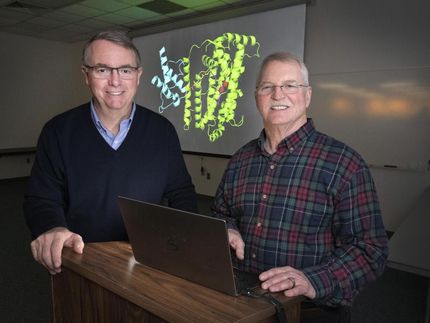The ATM strikes back
Hot foam may soon send criminals running if they damage ATM. ETH researchers have developed a special film that triggers an intense reaction when destroyed. The idea originates from a beetle that uses a gas explosion to fend off attackers.
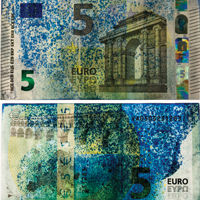
Front and back of a EUR 5 banknote, dyed blue by the self-defending surface.
ETH Zürich
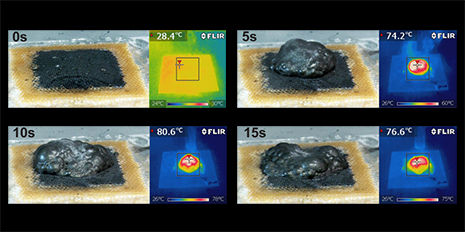
The series of images of the destruction tests in the laboratory shows how the foam is released by the self-defending film. The infrared images show a temperature rise to 80 degrees.
ETH Zürich
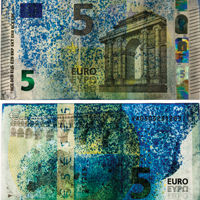
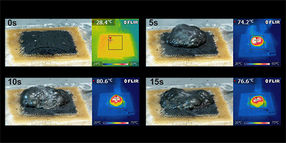
Its head and pronotum are usually rusty red, and its abdomen blue or shiny green: the bombardier beetle is approximately one centimetre long and common to Central Europe. At first glance, it appears harmless, but it possesses what is surely the most aggressive chemical defence system in nature. When threatened, the bombardier beetle releases a caustic spray, accompanied by a popping sound. This spray can kill ants or scare off frogs. The beetle produces the explosive agent itself when needed. Two separately stored chemicals are mixed in a reaction chamber in the beetle's abdomen. An explosion is triggered with the help of catalytic enzymes.
“When you see how elegantly nature solves problems, you realise how deadlocked the world of technology often is,” says Wendelin Jan Stark, a professor from the ETH Department of Chemistry and Applied Biosciences. He and his team therefore looked to the bombardier beetle for inspiration and developed a chemical defence mechanism designed to prevent vandalism – a self-defending surface composed of several sandwich-like layers of plastic. If the surface is damaged, hot foam is sprayed in the face of the attacker. This technology could be used to prevent vandalism or protect valuable goods. “This could be used anywhere you find things that shouldn't be touched,” said Stark. In agriculture and forestry, for example, it could be used to keep animals from gnawing on trees.
Like a fuse
The researchers use plastic films with a honeycomb structure for their self-defending surface. The hollow spaces are filled with one of two chemicals: hydrogen peroxide or manganese dioxide. The two separate films are then stuck on top of each another. A layer of clear lacquer separates the two films filled with the different chemicals. When subjected to an impact, the interlayer is destroyed, causing the hydrogen peroxide and manganese dioxide to mix. This triggers a violent reaction that produces water vapour, oxygen and heat. Whereas enzymes act as catalysts in the bombardier beetle, manganese dioxide has proven to be a less expensive alternative for performing this function in the lab.
The researchers report that the product of the reaction in the film is more of a foam than a spray when compared to the beetle, as can be seen in slow motion video footage. Infrared images show that the temperature of the foam reaches 80 degrees. Just as in nature, very little mechanical energy is required in the laboratory to release a much greater amount of chemical energy – quite similar to a fuse or an electrically ignited combustion cycle in an engine.
Attacks on ATMs on the rise
The newly developed film may be particularly well suited to protecting ATMs or cash transports, write the researchers in their paper published in the Journal of Materials Chemistry A. In ATMs, banknotes are kept in cash boxes, which are exchanged regularly. The Edinburgh-based European ATM Security Team reports that the number of attacks on ATMs has increased in recent years. During the first half of 2013, more than 1,000 attacks on ATMs took place in Europe, resulting in losses of EUR 10 million.
While protective devices that can spray robbers and banknotes already exist, these are mechanical systems, explains Stark. A small motor is set in motion when triggered by a signal from a sensor. This requires electricity, is prone to malfunctions and is expensive.” The objective of his research group is to replace complicated control systems with cleverly designed materials.
Rendering banknotes useless
This is precisely the goal of the self-defending surface. To protect the cash boxes, the researchers prepare the film by adding manganese dioxide. They then add a dye along with DNA enveloped in nanoparticles. If the film is destroyed, both the foam and the dye are released, thereby rendering the cash useless. The DNA nanoparticles that are also released mark the banknotes so that their path can be traced. Laboratory experiments with 5 euro banknotes have shown that the method is effective. The researchers write that the costs are also reasonable and expect one square meter of film to cost approximately USD 40.
In a similar earlier project, ETH researchers developed a multi-layer protective envelope for seed that normally undergoes complex chemical treatment. Researchers emulated the protective mechanism of peaches and other fruit, which releases toxic hydrogen cyanide to keep the kernels from being eaten. Wheat seeds are coated with substances that also form hydrocyanic acid when they react. However, the base substances are separated from each other in different layers and react only when the seeds are bitten by a herbivore. Stark describes the successful research method as “imitating nature and realising simple ideas with high-tech methods.”
Original publication
Halter JG, Cohrs NH, Hild N, Paunescu D, Grass RN, Stark WJ: Self-defending anti-vandalism surfaces based on mechanically triggered mixing of reactants in polymer foils. J. Mater. Chem. A, Online-Publikation 7. März 2014
Halter JG, Chen WD, Hild N, Mora CA, Stoessel PR, Koehler FM, Grass RN, Stark WJ: Induced cyanogenesis from hydroxynitrile lyase and mandelonitrile on wheat with polylactic acid multilayer-coatings produces self-defending seeds, J. Mat. Chem. A, 2014, 2: 853-858

